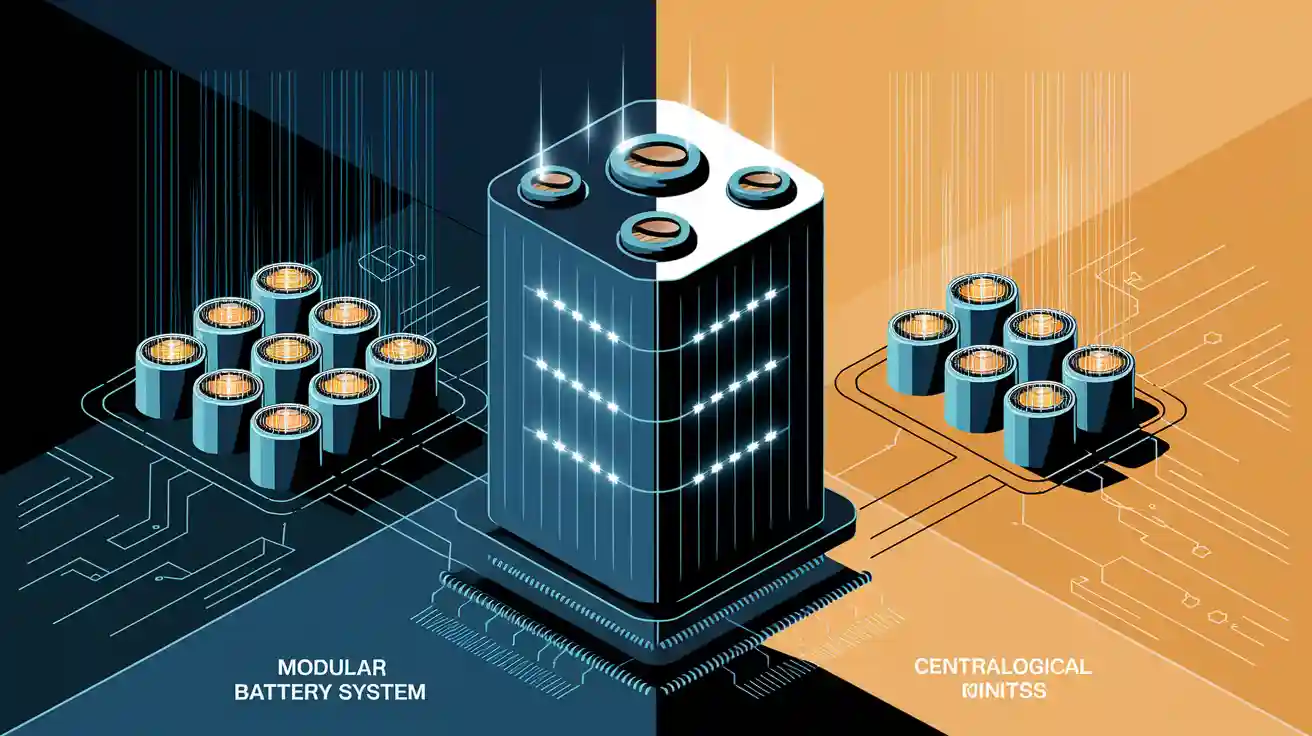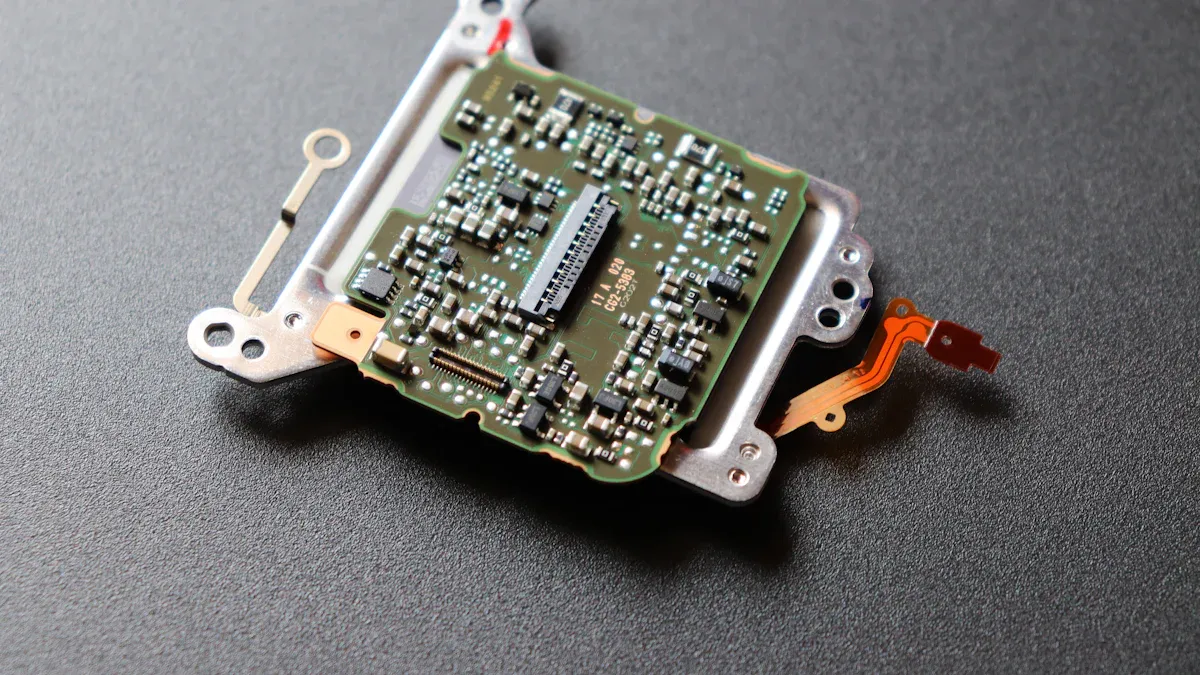
Battery systems play a vital role in energy storage and management. Modular battery systems consist of smaller, independent units that work together, offering a modular nature that allows you to scale and adapt as needed. In contrast, centralized systems rely on a single, unified structure to store energy on a large scale. The modular approach prioritizes flexibility and scalability, making it ideal for evolving energy needs. Centralized systems, however, focus on efficiency for fixed, high-capacity operations. Choosing the right system impacts long-term efficiency and ensures your energy demands are met effectively.
Key Takeaways
Modular battery systems are flexible. You can add or remove parts as needed.
Centralized battery systems cost less for big setups but lack flexibility.
Modular systems are more reliable. If one part breaks, others still work.
It’s easier to fix modular systems. You can repair one part without stopping everything.
Pick the right system for your needs. Modular systems work for changing needs, while centralized ones are better for steady, big operations.
Understanding Modular and Centralized Battery Systems

Modular Battery Systems
Definition and Key Features
A modular battery system consists of multiple independent units that work together to store and manage energy. Each unit operates with its own battery management system, ensuring localized control and monitoring. This design allows you to scale the system by adding or removing modules based on your energy needs. The modular architecture enhances reliability since the system can continue functioning even if one module fails. Additionally, the distributed battery management system ensures efficient operation and reduces the risk of a complete system failure.
Applications, Including Modular UPS Systems
Modular battery systems are widely used in various applications, including modular UPS systems. A modular UPS system provides uninterrupted power supply by combining multiple battery modules. You can expand the system easily as your power requirements grow, making it ideal for businesses with evolving energy demands. Unlike conventional UPS systems, which require replacing the entire unit to increase capacity, modular UPS systems allow you to add modules incrementally. This flexibility ensures cost-effectiveness and adaptability. Furthermore, modular UPS systems often include redundant battery modules, ensuring continuous power even during maintenance or module failures.
Centralized Battery Systems
Definition and Key Features
A centralized battery system relies on a single, unified structure to store and manage energy. It uses a centralized battery management system to control all the cells within the system. This centralized battery architecture simplifies the design and is often used for large-scale energy storage. However, the reliance on a single control unit makes the system less flexible and more vulnerable to failures. Scaling a centralized system typically requires replacing the entire unit, which can be costly and time-consuming.
Applications and Limitations
Centralized battery systems are commonly used in industrial settings and large-scale renewable energy projects. They are well-suited for applications requiring high-capacity energy storage with minimal changes over time. However, their centralized battery architecture limits scalability and flexibility. If your energy needs increase, you may need to replace the entire system. Additionally, the centralized design creates a single point of failure, which can lead to complete system downtime in case of a malfunction.
Attribute | Centralized Systems | Modular Systems |
|---|---|---|
Architecture | Single control unit for all cells | Individual monitoring units for each cell |
Scalability | Limited, requires entire unit replacement | High, can add/remove modules easily |
Reliability | Dependent on main unit | Enhanced, can operate with module failures |
Flexibility | Less flexible, centralized decision-making | High flexibility with localized decisions |
Tip: If you need a scalable and reliable solution, consider modular systems. For fixed, large-scale operations, centralized systems may be more suitable.
Key Comparison Factors
Scalability
Modular battery scalability and distributed battery architecture
When it comes to scalability, modular battery systems excel due to their distributed battery architecture. You can expand these systems effortlessly by adding more modules without redesigning the entire setup. This makes them ideal for growing energy demands. A scalable battery management system ensures that each module operates independently, maintaining efficiency even as the system grows.
System Type | Scalability Description |
|---|---|
Centralized BMS | Limited scalability due to the need for significant redesign |
Distributed BMS |
Quantitative benchmarks further highlight the advantages of modular systems. For instance, a 4-hour device achieves a capacity factor of 16.7%, while a 2-hour device reaches 8.3%. These metrics demonstrate how modular systems adapt to varying energy needs, ensuring ease of system scaling.
Challenges in scaling centralized systems
Centralized systems face significant challenges in scalability. Expanding these systems often requires a complete redesign, which can be both costly and time-consuming. The centralized battery management system lacks the flexibility to accommodate incremental growth. This limitation makes centralized systems less suitable for applications with evolving energy requirements.
Flexibility
Adaptability of modular systems to changing needs
Modular battery systems offer unmatched flexibility. Their distributed battery architecture allows you to adapt to changing energy demands seamlessly. If one module encounters a fault, the rest of the system continues to operate, ensuring operational continuity. This resilience enhances power system resilience and reduces downtime. Additionally, modular systems lower electrical energy protection costs, making them a cost-effective choice for dynamic environments.
Fixed configurations in centralized systems
Centralized systems, on the other hand, rely on fixed configurations. This rigidity limits their ability to adapt to new requirements. A single point of failure can disrupt the entire system, leading to significant downtime. Unlike modular systems, centralized setups lack the flexibility needed for seamless transition during faults or upgrades.
Reliability
Redundancy in modular systems and distributed BMS
Reliability is a key strength of modular systems. The distributed BMS ensures that faults remain isolated to specific modules, preventing system-wide outages. This redundancy enhances system reliability and supports operational continuity. Maintenance becomes easier as you can service individual modules without shutting down the entire system. These advantages of using a distributed BMS make modular systems a reliable choice for critical applications.
Single point of failure in centralized systems
Centralized systems struggle with reliability due to their design. A single point of failure can lead to widespread power loss, compromising power system resilience. This vulnerability makes centralized systems less reliable compared to modular setups. Distributed battery architecture, by contrast, ensures that failures remain localized, preserving the overall functionality of the system.
Maintenance
Ease of servicing modular systems
Modular battery systems simplify maintenance by isolating faults to individual modules. This design allows you to service or replace a single module without disrupting the entire system. The distributed battery management system further enhances serviceability by providing localized control and monitoring. You can identify and address issues quickly, reducing downtime and maintenance costs. Modular systems also lower the cost of DC power protection since each battery cabinet group operates independently.
Feature | Centralized Battery Systems | Modular Battery Systems |
|---|---|---|
Maintenance Complexity | Higher due to single point of failure | Lower, as faults can be isolated |
Cost of DC Power Protection | Higher, as each BCB must handle N-1 strings | Lower, as each BCB manages only its cabinet group |
Serviceability | Difficult, affects all cabinets during maintenance | Easier, allows for individual cabinet servicing |
Fault Tolerance | Limited, risk of system-wide shutdowns | Enhanced, isolates faults effectively |
Overall Cost Efficiency | Typically higher due to centralized logic | Potentially lower when considering total costs |
Complexity of centralized system maintenance
Centralized systems present challenges during maintenance. A single point of failure can disrupt the entire system, making repairs more complex and time-consuming. Servicing centralized systems often requires shutting down all cabinets, which increases downtime. The centralized battery management system lacks the flexibility to isolate faults, leading to higher costs and reduced efficiency. These factors make centralized systems less practical for applications requiring frequent maintenance.
Energy Efficiency
Efficiency of modular systems under varying loads
Modular systems excel in energy efficiency under varying loads. The distributed battery management system ensures optimal performance by managing each module independently. This design minimizes energy losses and maintains stable output voltages, even during load fluctuations. Efficiency calculations, such as the ratio of output power to input power, highlight the superior performance of modular systems. Additionally, power loss distributions focus on optimizing components like switches and diodes, further enhancing efficiency.
Efficiency Calculations: Modular systems maintain high efficiency by optimizing the ratio of output to input power.
Power Loss Distributions: Energy dissipation points are minimized, ensuring better performance.
Stable Output Voltages: Modular systems regulate voltage effectively, even under fluctuating loads.
Efficiency of centralized systems in large-scale operations
Centralized systems perform well in large-scale operations with consistent energy demands. However, their efficiency decreases under varying loads due to the lack of localized control. The centralized battery management system struggles to adapt to fluctuations, leading to higher energy losses. While centralized systems can handle high-capacity operations, their rigid design limits their ability to optimize energy efficiency dynamically.
Cost
Initial and long-term costs of modular systems
Modular systems often have higher initial costs due to their advanced design and distributed battery management system. However, their scalability and reliability reduce long-term expenses. You can expand the system incrementally, avoiding the need for costly replacements. Modular UPS systems enhance reliability and minimize costs associated with power interruptions. These factors make modular systems a cost-effective choice for applications with evolving energy needs.
Cost-effectiveness of centralized systems
Centralized systems offer lower initial costs, making them attractive for large-scale operations. However, their long-term expenses can be higher due to maintenance challenges and the need for extensive protection devices. Increased cabinet numbers in centralized setups complicate current management and raise costs. While centralized systems may seem cost-effective initially, their limitations in scalability and reliability can lead to higher overall expenditures.
Advantages and Disadvantages

Advantages of Modular Battery Systems
Scalability and Flexibility
Modular battery systems excel in scalability and flexibility. You can expand these systems as your energy needs grow, making them ideal for dynamic environments like manufacturing or large-scale operations. A scalable battery management system (BMS) ensures seamless integration of additional modules without disrupting existing operations. This adaptability also allows you to adjust the system for varying applications, such as modular UPS setups, which provide reliable backup power for businesses with evolving demands.
Key Benefits:
Fault tolerance ensures uninterrupted backup during module failures.
Lower DC power protection costs enhance overall efficiency.
Enhanced Reliability with Distributed BMS
Reliability is a standout feature of modular systems. The distributed BMS isolates faults to specific modules, preventing system-wide failures. This design ensures continuous backup power, even during maintenance or unexpected issues. Improved availability reduces the risk of downtime, making modular systems a dependable choice for critical applications.
Advantage | Description |
|---|---|
Fault Tolerance | Distributed systems can isolate faults, ensuring uninterrupted power supply. |
Availability | Improved availability reduces risks of system-wide shutdowns. |
Cost Savings | Lower DC power protection costs enhance overall efficiency. |
Disadvantages of Modular Battery Systems
Higher Initial Costs
The advanced design of modular battery systems often results in higher upfront costs. Each module requires its own BMS, which increases the initial investment. However, these costs are offset by lower operational expenses and the ability to expand incrementally without replacing the entire system.
Potential Inefficiencies in Small-Scale Setups
Modular systems may not be the best choice for small-scale applications. The distributed architecture can lead to inefficiencies when energy demands are minimal. In such cases, centralized systems might offer a more cost-effective solution.
Advantages of Centralized Battery Systems
Cost-Effectiveness for Large-Scale Operations
Centralized systems are cost-effective for large-scale operations with consistent energy demands. Their simplified design reduces initial costs, making them an attractive option for industrial settings. While maintenance costs can be higher, centralized systems optimize energy storage capacity, ensuring reliable backup power for high-capacity applications.
Key Benefits:
Lower initial costs compared to modular setups.
Simplified system design reduces installation complexity.
Simplified System Design
The unified structure of centralized systems simplifies their design and operation. A single BMS manages all cells, streamlining monitoring and control. This simplicity makes centralized systems easier to implement in fixed, large-scale environments where scalability is not a priority.
Tip: If your energy needs are stable and large-scale, centralized systems can provide a cost-effective and straightforward solution.
Disadvantages of Centralized Battery Systems
Limited Scalability
Centralized battery systems struggle to adapt to growing energy demands. Their design relies on a single, unified structure, which makes expansion difficult. If your energy needs increase, you often need to replace the entire system. This process can be both expensive and time-consuming. Unlike modular systems, centralized setups lack the flexibility to add or remove components incrementally. This limitation makes them less suitable for dynamic environments where energy requirements frequently change.
The lack of scalability also impacts long-term efficiency. As your energy demands grow, centralized systems may become outdated faster. This forces you to invest in new infrastructure sooner than expected. For businesses or projects with evolving energy needs, this can lead to higher costs and operational disruptions.
Higher Risk of Total System Failure
Centralized systems face a significant risk of total failure due to their reliance on a single control unit. If this central component malfunctions, the entire system can shut down. This creates a single point of failure, which can compromise the reliability of your energy storage. In critical applications, such as hospitals or data centers, this risk can have severe consequences.
Maintenance challenges further increase this vulnerability. Servicing a centralized system often requires shutting down the entire setup. This downtime can disrupt operations and lead to financial losses. In contrast, modular systems isolate faults to individual modules, ensuring continuous operation even during maintenance. The centralized design also makes it harder to identify and address issues quickly, which can prolong outages.
Note: If reliability and scalability are priorities for your energy storage needs, consider exploring modular systems as an alternative.
Choosing the Right System for Long-Term Efficiency
Factors to Consider
Application size and energy demands
When selecting a battery system, you must evaluate your application size and energy demands. For instance, systems with higher capacity factors, such as a 4-hour device with 16.7%, perform better over time compared to a 2-hour device with 8.3%. Usage assumptions, like one cycle per day, also influence performance. If your energy needs fluctuate, modular systems provide scalability to accommodate growth. Real-time monitoring and data logging further enhance their adaptability, ensuring optimal performance and battery health.
On the other hand, centralized systems suit applications with consistent energy demands. These systems excel in large-scale operations where energy requirements remain stable. However, their lack of scalability may limit their long-term efficiency in dynamic environments.
Budget constraints and cost considerations
Budget plays a critical role in your decision-making process. Modular systems often have higher initial costs due to their advanced design. However, their ability to expand incrementally reduces long-term expenses. For residential battery energy storage systems, both power capacity and energy storage capacity impact costs. Accurate cost estimation requires considering these factors alongside potential degradation rates, which may necessitate system replacement over time.
Centralized systems, while cost-effective initially, may incur higher maintenance and replacement costs. Their inability to scale efficiently can lead to additional expenses as energy demands grow. Balancing upfront investment with long-term savings is essential for making an informed choice.
Choosing between modular and centralized battery systems requires understanding their key differences. Modular systems offer high scalability, enhanced reliability, and easier maintenance due to their distributed structure. Centralized systems, however, provide simpler designs and cost-effectiveness for stable, large-scale operations. The table below highlights these distinctions:
Feature | Centralized BMS | Distributed BMS |
|---|---|---|
Control Structure | Single unit | Multiple units |
Scalability | Limited | High |
Reliability | Single point of failure | Redundant, lower risk |
Complexity | Simpler design | More complex due to multiple units |
Aligning your choice with long-term efficiency goals ensures optimal performance and cost savings. For instance, modular systems excel in dynamic environments, while centralized systems suit consistent energy demands. The following table reinforces the importance of matching your energy storage needs with the right system:
Aspect | Centralized Systems | Distributed Systems |
|---|---|---|
Cost Efficiency | Higher costs due to single BCB sizing | Lower costs by managing current within cabinets |
Reliability | Single point of failure | Enhanced reliability with multiple strings |
Maintenance | Difficult due to interdependencies | Easier serviceability and fault containment |
Power Supply Continuity | Risk of total shutdown during maintenance | Continuous power supply during faults |
Ultimately, your decision depends on specific needs, including scalability, cost, and performance requirements. By aligning these factors with your energy goals, you can ensure long-term efficiency and reliability.
FAQ
What is the main difference between modular and centralized battery systems?
Modular systems consist of independent units that you can scale easily. Centralized systems rely on a single, unified structure. This makes modular systems more flexible and scalable, while centralized systems are better suited for fixed, large-scale operations.
Which system is more reliable for critical applications?
Modular systems are more reliable due to their distributed design. If one module fails, the rest continue to operate. Centralized systems, however, have a single point of failure, which can lead to complete system downtime.
Are modular systems more expensive than centralized systems?
Modular systems often have higher initial costs because of their advanced design. However, their scalability and lower maintenance expenses make them cost-effective in the long run. Centralized systems may seem cheaper initially but can incur higher costs over time.
Can centralized systems handle growing energy demands?
Centralized systems struggle with scalability. Expanding them often requires replacing the entire setup, which is costly and time-consuming. Modular systems, on the other hand, allow you to add or remove modules as your energy needs change.
Which system is better for dynamic environments?
Modular systems are better for dynamic environments. Their flexibility and scalability make them ideal for applications with evolving energy demands. Centralized systems are more suitable for stable, large-scale operations with consistent energy requirements.






